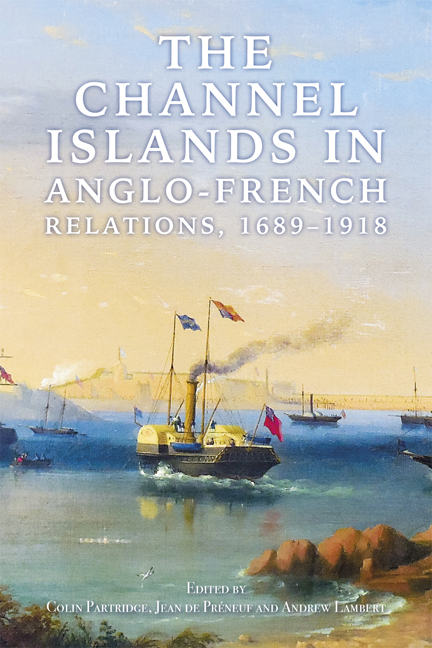Book contents
- Frontmatter
- Dedication
- Contents
- List of Illustrations
- List of Contributors
- Preface
- Introduction: ‘The Ehrenbreitstein of the English Channel’
- Part 1 Corsairs – the Ancien Régime and French Wars from 1689
- Part 2 The Islands – French and British Intelligence from the Seven Years War to 1815
- Part 3 Territorial Waters – the Land and Sea Interface from the 17th to 20th Centuries
- Part 4 Engineering Strategic Change
- Part 5 Alderney and the Channel Islands – Naval Strategy from 1815 to 1905
- Part 6 Civil Societies and Anglo-French Naval Rivalry – the 19th Century to WWI
- Part 7 Trade War – the Protection of Channel Islands Shipping in the Great War
- Afterword: Alderney, The Channel Islands, and the Study of History
- Bibliography
- Index
1 - Granville’s Privateers and Anglo-French Conflict in theSeventeenth and Eighteenth Centuries
Published online by Cambridge University Press: 15 May 2024
- Frontmatter
- Dedication
- Contents
- List of Illustrations
- List of Contributors
- Preface
- Introduction: ‘The Ehrenbreitstein of the English Channel’
- Part 1 Corsairs – the Ancien Régime and French Wars from 1689
- Part 2 The Islands – French and British Intelligence from the Seven Years War to 1815
- Part 3 Territorial Waters – the Land and Sea Interface from the 17th to 20th Centuries
- Part 4 Engineering Strategic Change
- Part 5 Alderney and the Channel Islands – Naval Strategy from 1815 to 1905
- Part 6 Civil Societies and Anglo-French Naval Rivalry – the 19th Century to WWI
- Part 7 Trade War – the Protection of Channel Islands Shipping in the Great War
- Afterword: Alderney, The Channel Islands, and the Study of History
- Bibliography
- Index
Summary
Saint-Malo and Dunkirk were mainland France's most important privateering centres, and are referred to constantly by historians in France and elsewhere in discussions of privateering. Their reputation often obscures the activity of other ports, which are unfairly left in the shadows despite having also engaged in such warfare, with varying degrees of participation and success. The Norman port of Granville is one such example. It was heavily involved in privateering throughout the Second Hundred Years War, but is rarely mentioned as one of the major privateer towns.1 Its population was small and its port cramped, but Granville's location in the Channel, along with its history, maritime wealth, naval potential and entrepreneurial spirit, encouraged its inhabitants to take up privateering. What were the driving forces behind this decision? What were the characteristics of this activity? What were the results?
Granville's cod fishing and privateering within a distinctive geopolitical context
According to tradition, Granville was founded by the English during the wars of the Middle Ages, on the west coast of what is now the Cotentin Peninsula in Normandy, when they were planning to invade France. Mont-Saint- Michel blocked their way to Brittany and hindered their progress towards the centre of the kingdom. Unable to capture it, in 1439 the English bought the almost uninhabited cliff of Cap Lihou. This rocky promontory, jutting out westwards into the sea only a few kilometres from Mont-Saint-Michel, offered an easily defendable position and a firm base for future operations. In 1440, they reinforced an enclosure on top of the cliff. To protect themselves from the possibility of the French returning, a deep trench was dug across the isthmus to the east that connected the peninsula to the mainland. Finally, they forced many in the surrounding area into the new enclosure (frontispiece). The English thereby created Granville, both as a stronghold and a town. The occupation did not last, however, and the town was taken three years later by the knights of Mont-Saint-Michel.
Thereafter, the town and its port grew in importance. Its inhabitants engaged in coastal shipping and oyster, freshwater and cod fishing. At the end of the seventeenth century, it seems its population was small. The commissioner general of fortifications, Vauban, stated in a report drawn up
- Type
- Chapter
- Information
- The Channel Islands in Anglo-French Relations, 1689-1918 , pp. 19 - 33Publisher: Boydell & BrewerPrint publication year: 2024



